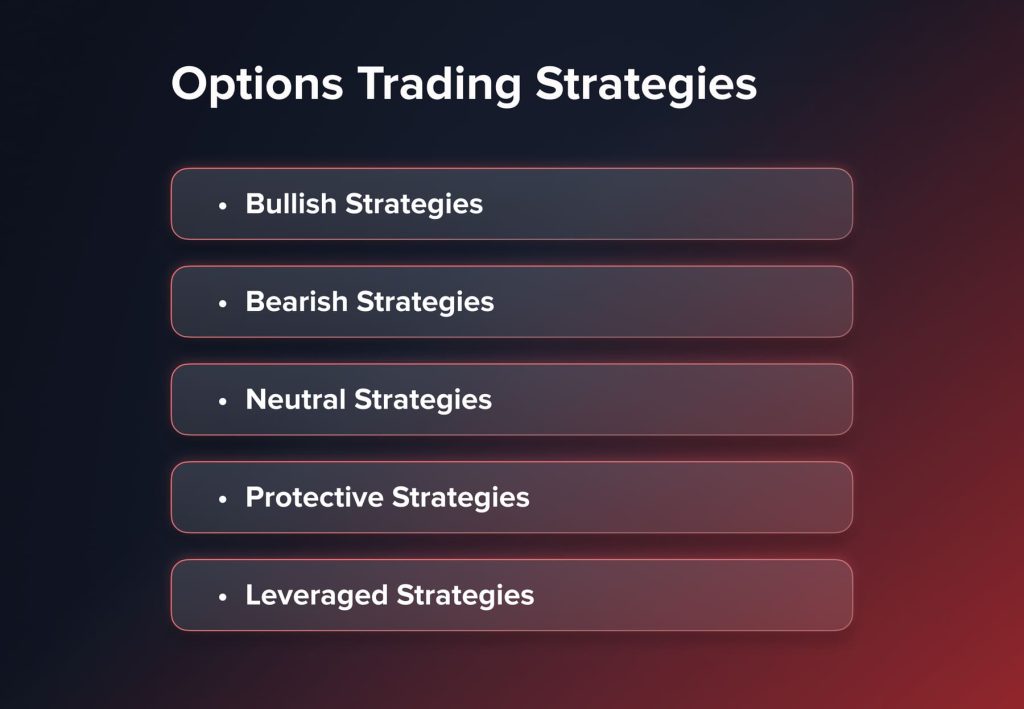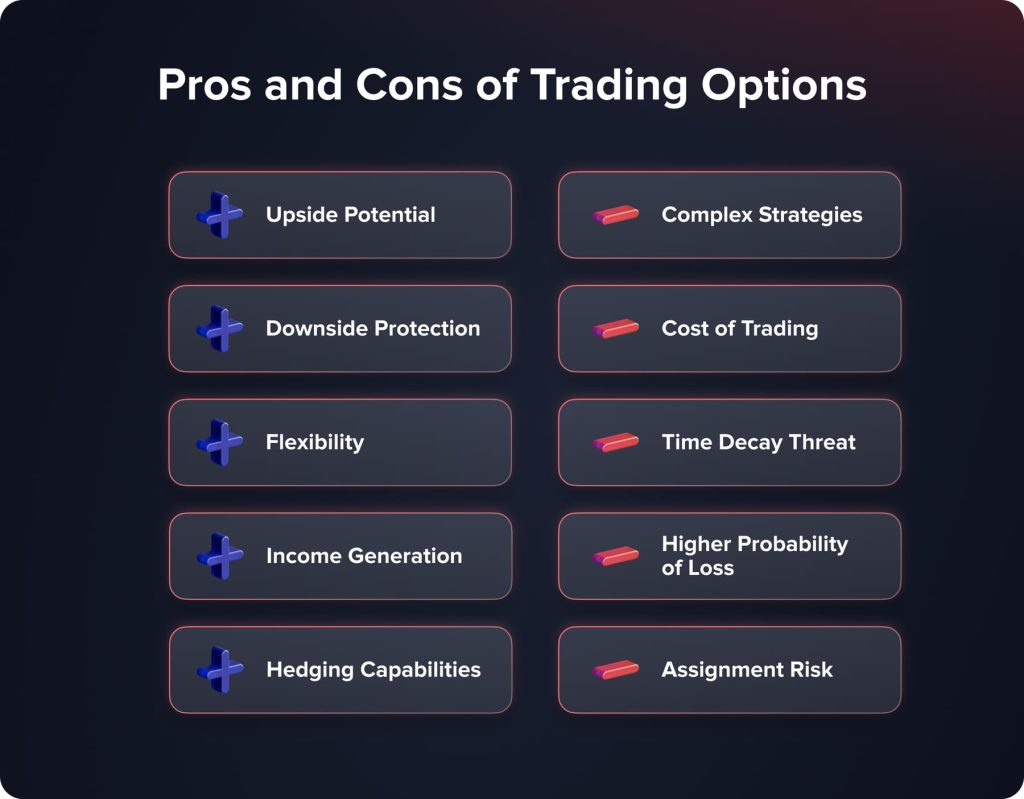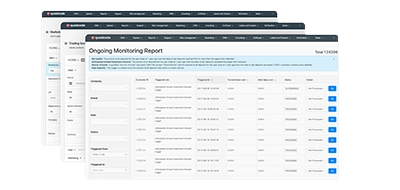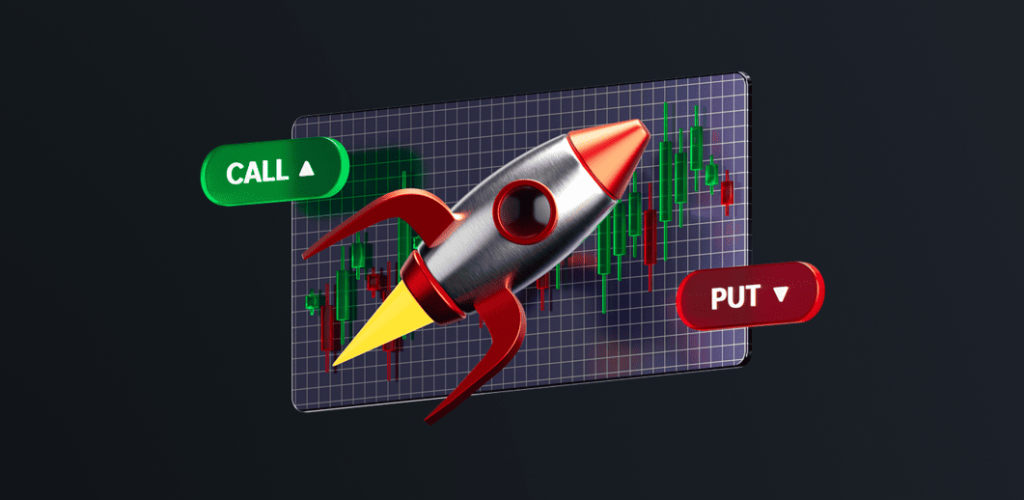Назад
Contents
Что такое торговля опционами и как она работает?

Demetris Makrides
Senior Business Development Manager

Vitaly Makarenko
Chief Commercial Officer
Что такое торговля опционами?
Торговля опционами позволяет инвесторам спекулировать на будущей доходности базовых активов, таких как акции, индексы, сырьевые товары или валюты, с определённым уровнем риска. По сути, опцион представляет собой контракт, предоставляющий покупателю особые права на покупку или продажу базового актива.
Существует два основных типа опционов: колл и пут. Колл-опцион даёт владельцу право купить базовый актив к определённой дате по определённой цене. Покупка колл-опциона хорошо подходит для бычьего прогноза, позволяя получить прибыль, если цена актива поднимется выше страйка. Пут-опцион, наоборот, предоставляет владельцу право продать базовый актив по цене страйка. Пут-опционы выгодны для медвежьего прогноза и приносят прибыль, если цена актива опустится ниже страйка.
Ключевые компоненты опционных контрактов
Базовый актив: ценная бумага, составляющая основу опционного контракта, например, акция, индекс, товар или валютная пара.
- Дата окончания срока: Последний день, когда опцион может быть исполнен до истечения его срока действия. Срок действия опционов может варьироваться от нескольких недель до нескольких лет.
- Цена исполнения: заранее определенная цена, по которой держатель может купить (опцион колл) или продать (опцион пут) базовый актив.
- Тип опции: Различает опцион колл, предоставляющий право покупки, и пут, предоставляющий право продажи.
- Премиум: Первоначальная цена, уплачиваемая покупателем за открытие опционной позиции. Это максимальный потенциальный убыток по сделке.
Однако опционы также имеют недостатки, такие как сложность, потеря времени и риск уступки, требующие тщательного управления. Анализ факторов, влияющих на цены, таких как «греки», требует постоянного изучения.
В целом, для опытных инвесторов опционы представляют собой универсальные инструменты, подходящие для достижения различных целей при разумном использовании в рамках допустимого уровня риска. Их договорная природа позволяет индивидуально подбирать позиции на бычьих, медвежьих или рыночных рынках. Давайте теперь рассмотрим опционы более подробно.
Ценообразование опционов и греки
Помимо переменных, заложенных в каждом опционном контракте, на их ценообразование динамически влияют различные взаимосвязанные рыночные факторы. Понимание чувствительности к этим факторам помогает трейдерам ориентироваться в условиях колебаний цен.
Факторы, влияющие на цены
- Цена базового актива: Основной определяющий фактор: стоимость опционов увеличивается по мере того, как базовые опционы превышают страйки колл-опционов или снижаются по сравнению с пут-опционами.
- Время до истечения: Опционы с близкой датой исполнения демонстрируют более резкий спад тета. Большая временная стоимость способствует более длительным срокам исполнения.
- Волатильность: Фактические и подразумеваемые объёмы влияют на премии. Нестабильные рынки завышают цены, в отличие от плавного движения.
- Процентные ставки: Более высокие ставки снижают стоимость заимствований для коротких позиций по опционам пут. Коллы выигрывают.
- Дивиденды: Распределение акций снижает внутреннюю стоимость опционов колл, если цена ниже страйков. Опционы пут растут незначительно.
Греки ценообразования опционов
- Дельта: Представляет собой скорость изменения теоретической стоимости опциона по отношению к изменению цены базового актива на 1 доллар.
- Опционы с приближением срока действия имеют дельты, близкие к 0 (для опционов «вне денег») или 1 (для опционов «глубоко в деньгах»), поскольку они ведут себя скорее как базовый актив.
- По мере приближения даты истечения срока опционы становятся либо более чувствительными (дельта увеличивается), либо менее чувствительными (дельта уменьшается) к изменениям базового актива.
- Гамма: Измеряет скорость изменения дельты опциона по отношению к изменению цены базового актива на 1 доллар.
- Более высокие параметры гаммы испытывают более резкие изменения в своей дельте.
- Опционы с более отдаленной датой истечения, как правило, имеют более высокую гамму, поскольку их дельты менее статичны.
- Вега: Измеряет скорость изменения теоретической стоимости опциона при изменении подразумеваемой волатильности на 1%.
- Цены обычно растут, если волатильность растет, и падают, если она падает.
- Опционы, близкие к истечению срока, имеют меньшие значения Веги, поскольку волатильность влияет на них меньше в течение их более короткого срока действия.
- Тета: представляет собой скорость снижения теоретической стоимости опциона при сокращении времени до истечения срока на один день.
- Тета accelerates as expiration nears, causing options to decay faster the shorter their lives.
- Для краткосрочных опционов сдвиг во времени на один день имеет большее значение.
- Ро: Измеряет скорость изменения цены опциона из-за изменения процентных ставок на 1%.
- Путы, как правило, растут в цене, когда ставки растут, а коллы — когда ставки падают, из-за паритета пут и колл.
- Краткосрочные опционы имеют меньшую подверженность корреляции по причине меньшего времени изменения ставок.
Подразумеваемая волатильность и технический анализ также влияют на ценообразование. Знание этих «греков» помогает стратегически ориентироваться в колеблющихся оценках деривативов.
Как работает торговля опционами
Теперь, когда мы разобрались с основами опционов, давайте углубимся в практические аспекты торговли ими. В этом разделе мы рассмотрим механизмы открытия и закрытия позиций, кредитное плечо, сопутствующие расходы, сценарии истечения срока действия, аналитические инструменты и стратегии управления рисками .
Открытие и закрытие позиций
Чтобы открыть позицию, трейдеры размещают рыночные ордера на покупку для открытия длинной позиции колл/пут или на продажу для открытия короткой позиции. Покупка устанавливает право исполнения, в то время как продажа обязывает к поставке, если она назначена.
Позиции закрываются путём продажи для закрытия длинной позиции или покупки для закрытия короткой позиции с целью получения прибыли или минимизации убытков. Брокеры осуществляют эти транзакции через платформы исполнения ордеров.
Требования к кредитному плечу и марже
Опционы мультипликативно влияют на доходность портфеля относительно динамики базовых активов. Однако, в отличие от акций, требующих полной стоимости покупки, маржинальные счета позволяют использовать кредитное плечо для увеличения покупательной способности.
Брокеры устанавливают уровни начальной и поддерживающей маржи, определяя необходимое обеспечение. Использовать увеличивает процентный прирост, но также усиливает падение, что требует разумного выбора размера.
Транзакционные издержки
Хотя некоторые сделки с акциями не облагаются комиссией, опционы предполагают брокерские сборы. Биржи также взимают регулирующие сборы, которые перекладываются на трейдеров. Структура затрат различается: по контракту, многоуровневое ценообразование или пакетные. Поиск недорогих специалистов способствует оптимизации. Налоги дополнительно влияют на прибыль в зависимости от сроков владения активом.
Истечение срока действия и уступка
Открытые позиции автоматически закрываются по истечении срока, если не были исполнены ранее. Опционы ITM могут быть переуступлены, что позволяет реализовать право продать или купить акции по цене страйка. Опционы OTM истекают без стоимости, ограничивая убыток премией. Трейдеры готовятся к этому, хеджируя риски в период экспирации или заблаговременно корректируя позиции.
Аналитические инструменты
Брокеры предоставляют котировки в режиме реального времени, графики и технические индикаторы. Скринеры фильтруют атрибуты контрактов. Греки раскрывают факторы чувствительности для управления волатильностью. Индивидуальные настройки позволяют реализовать различные стратегии, комплексно используя различные источники данных и показатели риска.
Стратегии управления рисками
Ключ к успеху — учитывать сложность опционов и правильно масштабировать позиции. Цели прибыли стоп-лоссы Диверсификация стратегии способствует дисциплинированному снижению рисков в условиях неизбежных спадов. Постоянное обучение также минимизирует ошибки.
В заключение, ответственная торговля требует извлечения выгоды из полезности опционов в рамках своих финансовых возможностей и опыта. Перейдём теперь к конкретным стратегиям.
Стратегии торговли опционами
В этом разделе представлен углубленный анализ различных стратегий торговли опционами, ориентированных на направление, волатильность и структурированную торговлю. Понимание различных подходов помогает трейдерам выбирать подходящие варианты, исходя из своего видения рынка, готовности к риску и таймфреймов.

1. Бычьи стратегии
- Длинные звонки: Покупка опционов колл позволяет использовать потенциал роста с ограниченным риском падения. Трейдеры могут ориентироваться на даты истечения опционов OTM, ATM или ITM, исходя из своих оптимистичных прогнозов. Потенциальная прибыль увеличивается экспоненциально по мере того, как базовый актив опережает цену исполнения плюс уплаченную премию.
- Покрытые звонки: Продавая опционы колл по удерживаемым акциям, трейдеры получают премию, ограничивая прирост. Короткие опционы колл, выставленные немного выше базовой стоимости, генерируют премию, если краткосрочные прогнозы нейтральны или умеренно оптимистичны. Недостатком является поставка акций по страйку.
2. Медвежьи стратегии
- Длинные путы: Пут-опционы представляют собой короткие позиции с использованием кредитного плеча, цена которых растет по мере снижения базового актива. Покупка опционов с истечением срока действия OTM, ATM или ITM подходит для ожиданий надвигающегося спада или для хеджирования коротких позиций по акциям.
- Короткие путы: Продажа пут-опционов с денежным обеспечением предполагает, что прорывы вниз будут незначительными, а премии останутся нетронутыми. Значительные прорывы требуют нежелательного открытия длинных позиций на уровне страйка. Это благоприятствует нейтральному прогнозу.
3. Нейтральные стратегии
- Стрэддлс: Покупка пар колл и пут с одинаковым страйком и датой исполнения уравновешивает волатильность и риски направления. Более широкие диапазоны, увеличивающие цены опционов, помимо премий, формируют прибыльность.
- Крытые стрэддлы: Сочетание длинной позиции по базовым акциям с продажей стрэддла приносит премиальный доход, ограничивая при этом неограниченную ответственность. Торговые диапазоны, охватывающие страйки, приносят прибыль.
4. Защитные стратегии
- Защитные путы: Покупка опционов пут с понижением соответствует длинным позициям в акциях, ограничивая падение цен премией без учета страйка. Опционы пут с понижением (OTM) позволяют сэкономить на страховке, компенсируя некоторую уязвимость.
- Ошейники: Длинные позиции по акциям в сочетании с защитными пут-опционами и колл-опционами с ориентацией на повышение защищают приемлемые торговые зоны от риска. Временной распад повышает вероятность успеха по сравнению со стратегиями прямых коротких позиций.
5. Стратегии с использованием заемных средств
- Длинные удушения: Ставки на путы и коллы вне рынка на повышенную волатильность, превышающую более высокие входные издержки. Превышение страйков по величине и умножение премий приводит к получению прибыли.
- Спреды: Вертикальные кредитные спреды ограничивают риск по сравнению с одиночными позициями за счёт сбора коротких премий. Бычьи и медвежьи варианты приносят прибыль, если ценные бумаги остаются в заданных диапазонах.
Как говорится, «опционы подходят не всем инвесторам». Несмотря на свою универсальность, их сложность требует постоянного изучения. Перед началом работы трейдерам следует проводить тщательную оценку, соответствующую их целям. Результат проявляется в глубоком понимании и применении, сочетающем теоретические знания с практическим опытом.
Плюсы и минусы торговли опционами

Преимущества торговли опционами
- Потенциал роста: Опционы обеспечивают кредитное плечо, позволяющее подвергаться изменениям в базовом активе в рамках определенного уровня риска уплаченной премии.
- Защита от убытков: Для тех, кто придерживается медвежьих взглядов, пут-опционы создают надежную защиту от падения, позволяя при этом участвовать в восходящих движениях.
- Гибкость: Инвесторы могут точно определять направление, величину и сроки изменения цен в зависимости от долгосрочных обязательств по владению акциями.
- Генерация дохода: Продажа покрытых колл-опционов или обеспеченных денежными средствами пут-опционов генерирует регулярный премиальный доход в дополнение к приросту капитала.
- Возможности хеджирования: Опционы способствуют снижению рисков портфеля за счет покупки защиты от снижения или компенсации бычьих и медвежьих позиций.
Минусы торговли опционами
- Комплексные стратегии: Продвинутые сделки, такие как спреды, стрэддлы и бабочки, требуют глубокого понимания греков и тайминга.
- Стоимость торговли: Брокерские комиссии и сборы взимаются при каждом открытии или закрытии опционных контрактов.
- Угроза распада во времени: Опционы предсказуемо теряют стоимость по мере приближения даты истечения срока, что требует активного управления или более раннего выхода.
- Более высокая вероятность потерь: Хотя риск ограничен, увеличение кредитного плеча из-за неправильных действий приводит к пропорциональной потере первоначальных капитальных вложений.
- Риск назначения: Те, кто продает опционы колл или пут, сталкиваются с потенциальной принудительной поставкой или получением базового актива в случае их исполнения.
Подводя итог, можно сказать, что торговля опционами вознаграждает за знания, но требует постоянного обучения для реализации их универсальных возможностей и разумного управления присущими рисками. Необходимо оценить как затраты, так и выгоды.
Как торговать опционами на акции
1. Оцените свою готовность
Прежде чем торговать опционами на реальные деньги, тщательно оцените своё финансовое положение, опыт инвестирования, готовность к риску и наличие свободного времени. Предварительная оценка этих факторов поможет определить, соответствуют ли опционы вашим потребностям и возможностям. Важно подходить к торговле опционами с правильным настроем, учитывая сопутствующий риск.
2. Выберите брокера
Изучите информацию о лучших брокерах, известных низкими торговыми издержками, надежными образовательными ресурсами и полезными аналитическими инструментами. Выберите брокера, который лучше всего соответствует вашим требованиям. Подайте заявку на открытие счета и пройдите процедуру отбора, чтобы оценить ваши знания и финансовые возможности. Открытие счета у подходящего брокера закладывает основу для вашей торговли опционами.
3. Создайте торговый план
Уделите время формализации ваших предполагаемых стратегий, разработав критерии входа и выхода для различных рыночных сценариев. Используйте инструменты бэктестинга для анализа гипотетической доходности, прежде чем воплощать план в жизнь с реальным капиталом. Тщательное планирование крайне важно для принятия взвешенных решений.
4. Разберитесь в налогах
Целесообразно изучить особенности налогообложения прибыли от опционов и акций в зависимости от периода. Понимание этих аспектов способствует долгосрочному успеху за счет максимизации посленалоговой прибыли в соответствии с налоговыми ставками для физических лиц.
5. Продолжайте обучение
Управление рисками требует постоянного обучения по мере изменения доступных продуктов, передовых практик и вашего опыта. Практикуйте управление рисками, начиная с консервативного подхода в симуляции и постепенно увеличивая объёмы сделок по мере роста квалификации. Постоянное обучение помогает трейдеру опционов ориентироваться на неизбежные колебания рынка.
Заключение
Освоение опционов как инструмента инвестиционного репертуара требует целенаправленного изучения фундаментальной теории и реальной практики, а не бумажного моделирования. Открытость к совершенствованию стратегий позволяет вам гибко реагировать на различные рыночные условия, что в долгосрочной перспективе способствует формированию сбалансированного портфеля.
Только рисковые фонды специально предназначены для высокорисковых активов, чтобы избежать эмоциональных реакций. Сохраняйте терпение, грамотно управляйте рисками посредством диверсификации и выбора размера позиции в соответствии с вашим планом. Рассматривайте опционы как дополнение к комплексным финансовым целям и уровню толерантности к риску. Регулярно пересматривайте стратегии и вносите коррективы, чтобы постоянно совершенствоваться.
Обновлено:
19 декабря 2024 г.




